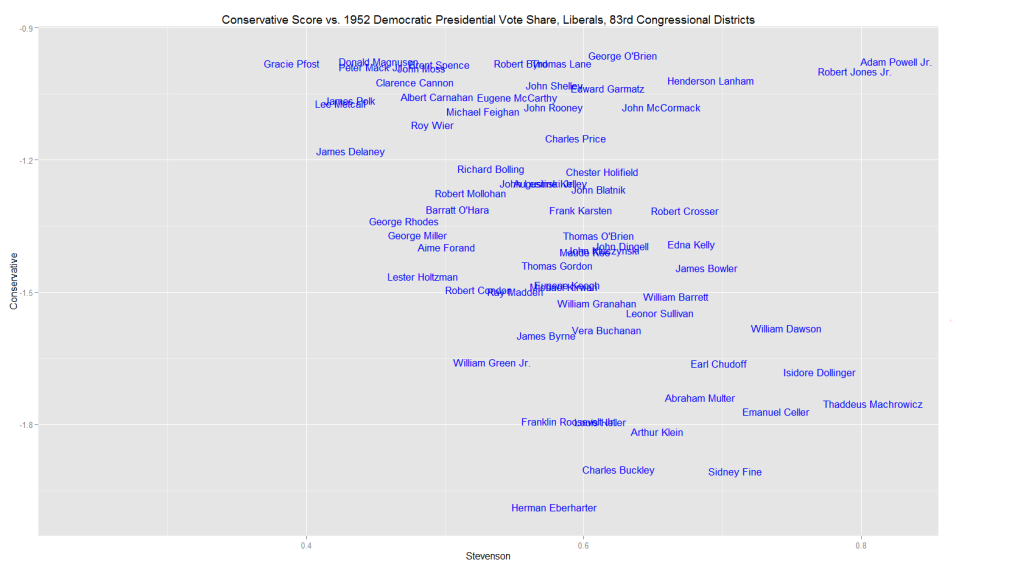In my last post, I wrote about which districts elected Democrats and Republicans to the 83rd House of Representatives(1953-1954). This didn't address the question: What kind of Democrats and Republicans?
One way to address this is to use an algorithm to assign, essentially, an ideological "score" (technically, a 1-dimensional ideal point) to each Representative based on how they voted. I used Simon Jackman's ideal/PSCL package, and applied it to every vote taken in the 83rd Congress, via GovTrack.
Here are the resulting scores, plotted against how well the Democratic nominee for President, Adlai Stevenson, did in the Representative's district. The higher on the graph a district is, basically, the more conservatively the Representative from that district voted. The farther right a district is, the better Stevenson did in the 1952 election.

I actually think this is a better "introductory" graph than the one in my first post, and I'm quite pleased with how much information it contains. For example, you can easily see the range of Stevenson percentages where both parties could get a Representative elected. Although it's hardly an original idea of mine. Jackman himself makes similar graphs for the current Congresses.
Many people, today, talk about the current state of "well-separated" parties--every Democrat is to the left of every Republican--as if it's a recent innovation. But the 83rd House of Representatives was quite well-separated. Only 2 Republicans--NY-21's Jacob Javits, and ND-AL's Usher Burdick--have "conservative scores" at or below -0.069, and just 1 Democrat--TX-05's Joseph Wilson--has a "conservative score" above -0.041, with no scores in between.
This suggests that party lines were reasonably strong in the roll calls of the 83rd House, although there were certainly cross-cutting issues, as I'll discuss in a future post.
The below scatterplot illustrates how well-separated the parties were: It's the Representatives with scores between -0.5 and 0.5, with a horizontal line added at -0.06.

Within the overall well-separated parties, as you can see from the labels in both charts, Southern Democrats were largely more conservative than Northern Democrats, but still less conservative than Republicans. There are only a few non-Southern Democratic moderates in the second chart.
We can also see that flukish KS-01 Congressman Howard Miller--who beat an incumbent in something like an R+16 district as Republicans were winning the House and Presidency--voted more liberally, on average, than quite a few Democrats in far safer seats (mostly Southerners). With a score of about -0.61, he's not even on that chart, despite having probably the most conservative district of any Democrat. His score is almost identical to Sam Rayburn's.
We can see that there was at least one non-Southern Democrat with a voting record considerably to the right of what their district might seem to support: NY-18's James Donovan, who succeeded radical Congressman Vito Marcantonio in 1950, with the support of both major parties. Perhaps such "fusion" support influenced his voting.
If we look at the top of the graph (here using names of Representatives) then we can see that the "most conservative" Representative (a bit of a simplification) was WI-02's Glenn Davis.
Davis' district was relatively conservative (about R+5: Stevenson got about 39% of the vote there) but not the most conservative in the country.
(If you remember the Wisconsin recalls, then it might amuse you that Davis, the most conservative member of the 83rd House by this measure, is also "the sole native of Waukesha County to have held Congressional office".)
Also note CA-12's Allan Hunter: An apparent conservative in a district that voted for Adlai Stevenson.
Looking at the bottom of the chart, we can see that Gracie Pfost, elected from Idaho's seemingly-Republican ID-01, was perhaps one of a few liberals elected from a conservative constituency. (Although ID-01 might have been a swing seat Congressionally, and Truman did well there in 1948.)

(And yes, the Representative next to Eugene McCarthy was A.S.J. Carnahan, of the current political family.)
Admittedly, I did define "liberals" so as to include Gracie Pfost, but since that's more or less also how you include Adam Clayton Powell, then I'll stand by it.
There are still differences between 1952 and today, of course.
Making an equivalent scatterplot for the 112th Congress would show a significant gap between the two parties, even between members from similar seats. Most Democrats are in a relatively narrow band with other Democrats, and most Republicans are in a relatively narrow band with other Republicans, although scores still somewhat vary with the partisanship of the district.
In the 83rd Congress, on the other hand, Democrats and Republicans in similar seats usually had fairly similar scores, and scores mostly varied with the partisanship of the district. The 1952 scatterplot looks, overall, something like a single diagonal line. A 2012 scatterplot would look more like two separate lines.
You might have noticed that I'm somewhat taking the numbers at face value, and I haven't discussed any actual votes yet.
And there are some oddities here. For example, Jacob Javits in NY-21--was he really no more liberal than a bunch of Southern Democrats? Javits, after all, had a perfect record on votes scored by the liberal Americans for Democratic Action in 1953, and was just one off from perfect in 1954. ADA scores generally match/correlated with 1-d ideal points very well, from what I recall.
The explanation? You probably need more than a single "conservativeness score" to look at voting in the 83rd House of Representatives. More technically, it's really better to look at 2-dimensional ideal points. And Javits stands out that way. More details on that in my next post.
No comments:
Post a Comment